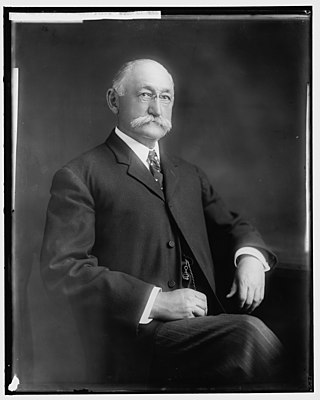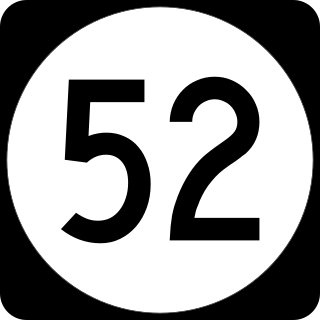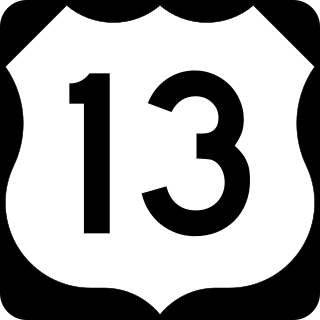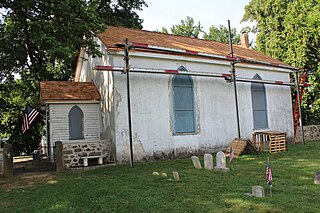
New Sweden was a colony of the Swedish Empire along the lower reaches of the Delaware River between 1638 and 1655 in present-day Delaware, Maryland, New Jersey, and Pennsylvania in the United States. Established during the Thirty Years' War when Sweden was a great power, New Sweden formed part of the Swedish efforts to colonize the Americas.

Wilmington is the largest city in the U.S. state of Delaware. The city was built on the site of Fort Christina, the first Swedish settlement in North America. It lies at the confluence of the Christina River and Brandywine Creek, near where the Christina flows into the Delaware River. It is the county seat of New Castle County and one of the major cities in the Delaware Valley metropolitan area. Wilmington was named by Proprietor Thomas Penn after his friend Spencer Compton, Earl of Wilmington, who was prime minister during the reign of George II of Great Britain.

The Hagley Museum and Library is a nonprofit educational institution in unincorporated New Castle County, Delaware, near Wilmington. Covering more than 235 acres (95 ha) along the banks of the Brandywine Creek, the museum and grounds include the first du Pont family home and garden in the United States, the powder yards, and a 19th-century machine shop. On the hillside below the mansion lies a Renaissance Revival garden, with terraces and statuary, created in the 1920s by Louise Evelina du Pont Crowninshield (1877–1958).

Caesar Rodney was an American Founding Father, lawyer, and politician from St. Jones Neck in Dover Hundred, Kent County, Delaware. He was an officer of the Delaware militia during the French and Indian War and the American Revolutionary War, a Continental Congressman from Delaware, a signer of the Continental Association and Declaration of Independence, and president of Delaware during most of the American Revolution.

The Delaware Colony, officially known as the three "Lower Counties on the Delaware", was a semiautonomous region of the proprietary Province of Pennsylvania and a de facto British colony in North America. Although not royally sanctioned, Delaware consisted of the three counties on the west bank of the Delaware River Bay.
Jacob Broom was an American Founding Father, businessman, and politician from Wilmington, Delaware. As a delegate to the U.S. Constitutional Convention of 1787, he was a signer of the United States Constitution. He was also appointed as a delegate to the Annapolis Convention in 1786 but did not attend, and he served in the Delaware General Assembly. He was the father of Congressman James M. Broom and grandfather of Congressman Jacob Broom.

Brandywine Creek is a tributary of the Christina River in southeastern Pennsylvania and northern Delaware in the United States. The Lower Brandywine is 20.4 miles (32.8 km) long and is a designated Pennsylvania Scenic River with several tributary streams. The East Branch and West Branch of the creek originate within 2 miles (3 km) of each other on the slopes of Welsh Mountain in Honey Brook Township, Pennsylvania, about 20 miles (32 km) northwest of their confluence.

Preston Lea was an American businessman and politician from Wilmington, in New Castle County, Delaware. He was a member of the Republican Party who served as Governor of Delaware.

Caleb Prew Bennett was an American soldier and politician from Wilmington, in New Castle County, Delaware. He was a veteran of the American Revolutionary War and the War of 1812, and a member of the Democratic Party who served as Governor of Delaware.

Cornelius Parsons Comegys was an American farmer and politician from Dover Hundred, in Kent County, Delaware, near Little Creek. He was a veteran of the War of 1812, a member of the Federalist Party, and then later the Whig Party, who served in the Delaware General Assembly and as Governor of Delaware.

John McKinly was an American physician and politician from Wilmington, Delaware. He was a veteran of the French and Indian War, served in the Delaware General Assembly, was the first elected President of Delaware, and for a time was a member of the Federalist Party.
Joseph Haslet was an American planter and politician from Cedar Creek Village in Cedar Creek Hundred, Sussex County, Delaware. He was a member of the Democratic-Republican Party, who served twice as Governor of Delaware.
The history of Delaware as a political entity dates back to the early colonization of North America by European settlers. Delaware is made up of three counties established in 1638, before the time of William Penn. Each county had its own settlement history. The state's early colonists tended to identify more closely with their county than Delaware as a whole. Large parts of southern and western Delaware were thought to have been in Maryland until 1767. The state has existed in the wide economic and political circle of the nearby Pennsylvanian city of Philadelphia.

Delaware Route 52 (DE 52) is a state highway in New Castle County, Delaware. The route runs from U.S. Route 13 Business in downtown Wilmington north to Pennsylvania Route 52 (PA 52) at the Pennsylvania border near Centerville. DE 52 runs through the city of Wilmington and passes through areas of the Brandywine Valley north of Wilmington. DE 52 intersects Interstate 95 (I-95)/US 202 and DE 2 in Wilmington and DE 100/DE 141 and DE 82 in Greenville. The entire route is designated as part of the Brandywine Valley National Scenic Byway, a National Scenic Byway and Delaware Byway, while most of the route is also designated as part of the Harriet Tubman Underground Railroad Byway of the Delaware Byways system. The road was built as the Kennett Pike, a turnpike, between 1811 and 1813. The Kennett Pike was bought by Pierre S. du Pont in 1919 and was widened and paved before being sold to the State of Delaware for $1. The road received the DE 52 designation by 1936.

U.S. Route 13 Business is an 8.19-mile (13.18 km) business route of US 13 that runs through the heart of the city of Wilmington in New Castle County, Delaware, where US 13 bypasses downtown Wilmington to the east, running near Interstate 495 (I-495) and the Delaware River. US 13 Bus. begins at I-495 and US 13 at the southern border of Wilmington and heads north toward the downtown area, where it splits into a one-way pair. Past downtown, the business route heads through the northeastern part of the city on North Market Street before continuing through suburban Brandywine Hundred on Philadelphia Pike. US 13 Bus. reaches its northern terminus at US 13 in Claymont. US 13 Bus. is a four-lane road for much of its length.

Rodney Square is the public square and historic district in downtown Wilmington, Delaware, United States, named after American Revolutionary leader Caesar Rodney. A large equestrian statue of Rodney by James E. Kelly formerly stood in the front of the square until it was removed in 2020. The square was created in the early 20th century by John Jacob Raskob, who worked for Pierre S. du Pont. The City Beautiful movement served as the inspiration for the effort.

First State National Historical Park is a National Park Service unit which lies primarily in the state of Delaware but which extends partly into Pennsylvania in Chadds Ford. Initially created as First State National Monument by President Barack Obama under the Antiquities Act on March 25, 2013, the park was later redesignated as First State National Historical Park by Congress.

Newark Union Church and Cemetery is a historic meetinghouse and burial ground in Brandywine Hundred, Delaware near Carrcroft. Established in 1687, the cemetery is four acres in size and contains approximately 950 graves, including seven men who fought in the American Revolution and members of some the earliest settlers of the Brandywine Hundred. The cemetery is located less than a mile from the Washington-Rochambeau Revolutionary Route through Delaware. The adjacent Newark Union Church started as a Quaker meetinghouse but became a Methodist Episcopal church in 1845 and remained in use until 1970. Both the church and cemetery are listed on the National Register of Historic Places in 2020.
David C. Wilson was a 19th-century banker, businessman and railroad executive; and the third mayor of Wilmington, Delaware.

Wilmington and Brandywine Cemetery is a rural cemetery at 701 Delaware Avenue in Wilmington, Delaware. Founded in 1843, it contains over 21,000 burials on about 25 acres.
















